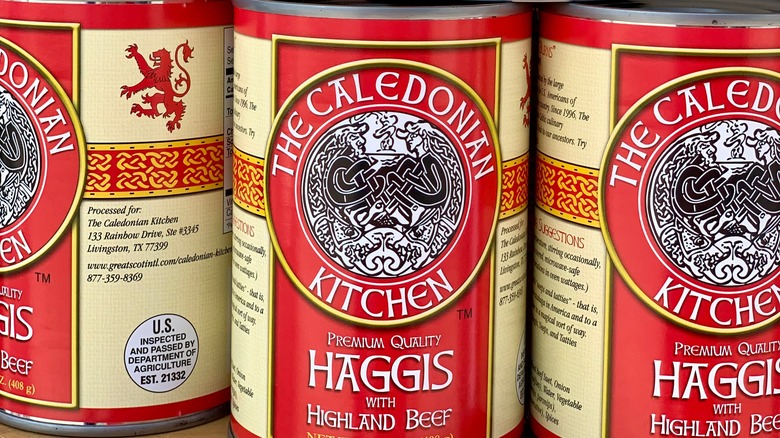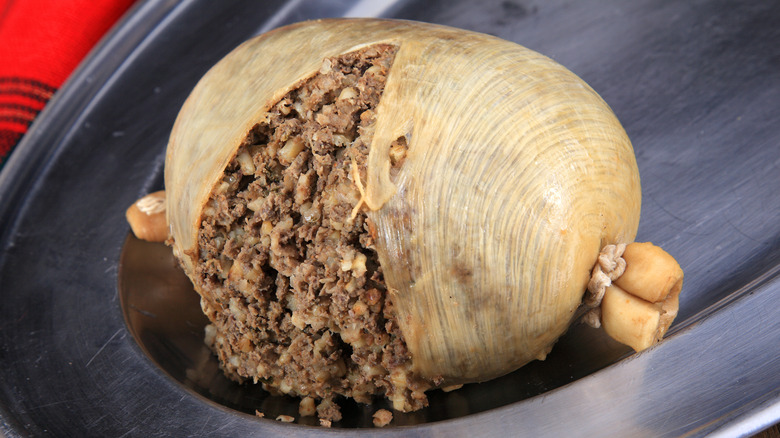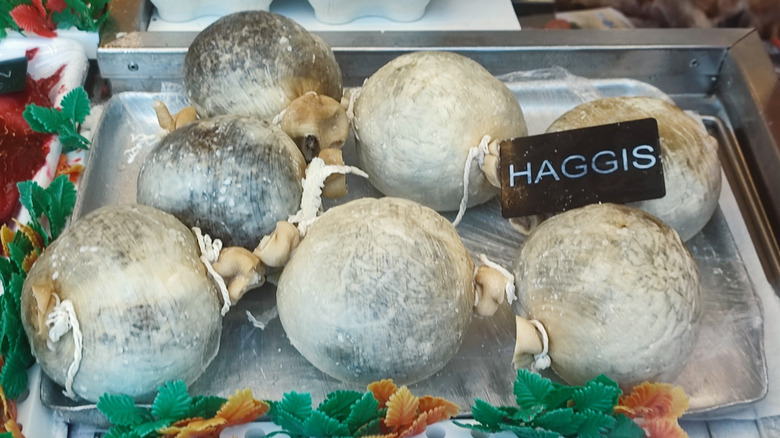Here's What You're Really Eating When You Crack Open A Can Of Haggis
We may receive a commission on purchases made from links.
Haggis is the national dish of Scotland, but it's the stuff of legend for many Americans. If you ask an American to name a few Scottish foods, they'll probably mention haggis, Scotch whisky, and maybe Scotch eggs (which are actually English, not Scottish). Unfortunately, haggis is often the subject of unfair ridicule in the U.S., with many folks writing it off as gross or unappetizing. Some don't even know what haggis is — in a 2003 survey, 33% of American tourists in Scotland thought haggis was a wild animal (via The Guardian).
Haggis is decidedly not a living creature. The dish traditionally consists of oatmeal, onion, beef fat, spices, and pluck — a blend of sheep's heart, liver, and lungs. The mixture is then soaked in stock and boiled in a sheep's stomach or sausage casing. The finished product is considered a pudding, although it bears little resemblance to the American conception of pudding as a sweet dessert (which is perhaps part of why it gets such a bad rap stateside).
Canned haggis in the U.S., however, is a bit different from the traditional version, as the USDA dictates that it mustn't contain sheep's lung (In fact, the agency forbids the sale of any lungs for human consumption). Instead, the canned version must rely on other parts of the animal, such as the aforementioned heart and liver, or even lamb rib meat. Some brands forego sheep altogether and make haggis from sirloin or Highland beef.
The USDA prevents the sale of traditional haggis in the States
In defense of the Americans who thought haggis was an animal, this idea is a long-running joke perpetuated by the Scottish tourism industry, complete with a hoax website that gives the infamous Pacific Northwest tree octopus a run for its money. Of course, this lack of haggis knowledge might not be so pervasive if the dish was more readily available stateside.
Some forms of haggis can be found in the U.S., mostly thanks to homesick Scots, but canned American haggis is hardly comparable to the customary Scottish version thanks to the USDA's longstanding ban on sheep's lung. This is unfortunate for lovers of the dish, as many Scots swear that the lung is an essential ingredient in the pudding, lending its texture a critical lightness.
The ban has often been criticized as unscientific, with many people — including some medical professionals who have reached out to the agency — arguing that eating lungs is no less safe than eating any other organ. At the time of this writing, however, lungs still can't be sold as human-grade food in the U.S., a ruling that has persisted since 1971.
How can you get haggis in America?
If you're an American who wants to try haggis, you can buy various canned versions online. Michigan-based Ackroyd's Scottish Bakery sells haggis prepared with lamb rib meat, heart, and liver, which it claims is "made in the most traditional way possible, in accordance with United States law." The Scottish Grocer, a North Carolina retailer that sells its wares on its website, makes canned haggis with U.S.-raised sirloin and liver. These and other U.S.-based haggis purveyors run a good business online and in specialty shops, but you're unlikely to find any form of haggis in a typical American supermarket.
Politicians and haggis lovers have been campaigning for a lift on the haggis ban for decades. A longstanding ban on sheep meat imports from the U.K. was lifted in 2021, but the lung issue persists, meaning it's nearly impossible to have the full Scottish haggis experience stateside (for now, Americans will have to settle for haggis-flavored potato chips). Alternatively, if you're a big fan of oatmeal in meat, try Cincinnati's goetta — in the spirit of haggis, it stretches out animal protein by mixing meat scraps with steel-cut oats.


